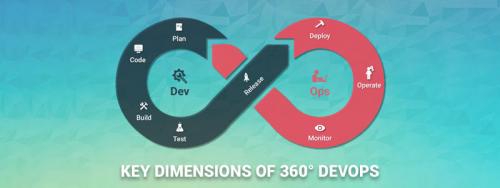The Key Dimensions of 360°DevOps

In times when the DevOps movement is in its full swing specially across the IT organizations, the way IT professionals view it is rather scattered and therefore the need to have a single view combining all aspects of DevOps is felt. Contrary to the popular belief, DevOps is not just confined to Development and operations but its scope is rather wide. To get an all-encompassing view of it and develop a better understanding of its scope, this article is an attempt to cover the key elements of DevOps.
Key elements of DevOps:
1. Customers
The first and foremost element of DevOps enablement is the customer for any organization. The first step is to understand the need of a customer to work out the solution that perfectly fits the bill for this need. Customer feedbacks are therefore instrumental in driving your DevOps movement. Hence, with the right strategy in place only can an organization get an insight into a 360-degree view of how its customer-facing systems are performing in terms of delivering business value to the customers. It also gives an insight into the consumer behavior based on which the organization can perform its ‘what-if’ analyses to mold its marketing and sales strategy accordingly. With the agile method of DevOps, the organizations are now quicker at responding to the market needs.
2. Business
While it may be important to implement DevOps for every organization regardless of its type and size, each organization is unique and so is its need to implement DevOps. So, your DevOps Implementation Service provider would design unique strategy tailored to cater to your exact needs. And before that, the business needs to consider whether an end-to-end implementation is required to meet their goals in the first place. If we take the analogy of a vehicle, while DevOps acts as a fuel to drive the lean practices in IT, the key to it is the organizational values and culture and the developmental methodology acts as its driver. With this example, it is rather easy to understand that making the right choice of fuel (DevOps Strategy) is critical to achieving top performance for your business operations. Just the way not every fuel can work with every vehicle, the businesses need to design the right blend of strategy to optimize their performance.
3. Development
DevOps serves to automate the tedious and manually accomplished tasks pertaining to build and deployment to let the developers focus on their key skills and make the most of those in adding to the productivity of the organization. While the developers enrich the organizations with the right set of tools and techniques, this adds value in terms of embedding good practices and processes to make the lives of the developers easier and make the entire process of development more efficient.
4. Operations
DevOps has been popular for its role as a bridge or an interface between the development and IT operations departments of an organization where it ensures that the two work closely, eliminating any scope for conflict between the two departments. DevOps culture encourages that any system is evaluated by both simultaneously for its scope and the impact of the changes planned leading to continuous development and improvement in the processes with a real-time evaluation.
SourcePost Your Ad Here
Comments